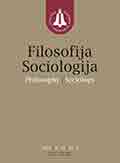Ar atsidavimą darbui skatinanti organizacija gali būti vyrų ir moterų darboholizmo prielaida?
Can an organization that promotes commitment to work be a prerequisite for workaholism in men and women?
Author(s): Modesta MorkevičiūtėSubject(s): Gender Studies, Labor relations, Management and complex organizations, Family and social welfare
Published by: Lietuvos mokslų akademijos leidykla
Keywords: workaholism; dedication-to-work promoting organisation; gender;
Summary/Abstract: There is contradictory scientific information on the role of employees’ gender in the relationship between the perceived dedication-to-work promoting organisation and workaholism. Some authors state that dedication to work promoting organisations foster males’ workaholism. Whereas the other authors assert that when working in such organisations, the risk of workaholism is higher for female employees. Contradictory results and a lack of scientific information do not allow us to formulate definitive conclusions. The questions about the development of workaholism among males and females in dedication to work promoting organisations remain unanswered. Therefore, the aim of this study was to determine the role of the employees’ gender for the relationship between the perceived dedication-to-work promoting organisation and workaholism. A survey that involved 964 employees (514 females and 450 males) working in different Lithuanian organisations was conducted in February–April 2021. A workaholism scale (DUWAS-10) proposed by W. B. Schaufeli et al. (2009) was used to assess workaholism. A questionnaire proposed by T. D. Allen (2001) was used to assess the perceptions of whether an organisation encourages employees to focus solely on work or whether it supports their family responsibilities as well. It was hypothesised that a positive relationship between the perceived dedication-to-work promoting organisation and workaholism was stronger for women. This assumption was confirmed. The results of the study propose that employees’ gender is the personal characteristic that determines how a person perceives the work environment and responds to the pressure to devote all the energy and time to work.
Journal: Filosofija. Sociologija
- Issue Year: 33/2022
- Issue No: 2
- Page Range: 138-148
- Page Count: 11
- Language: Lithuanian

